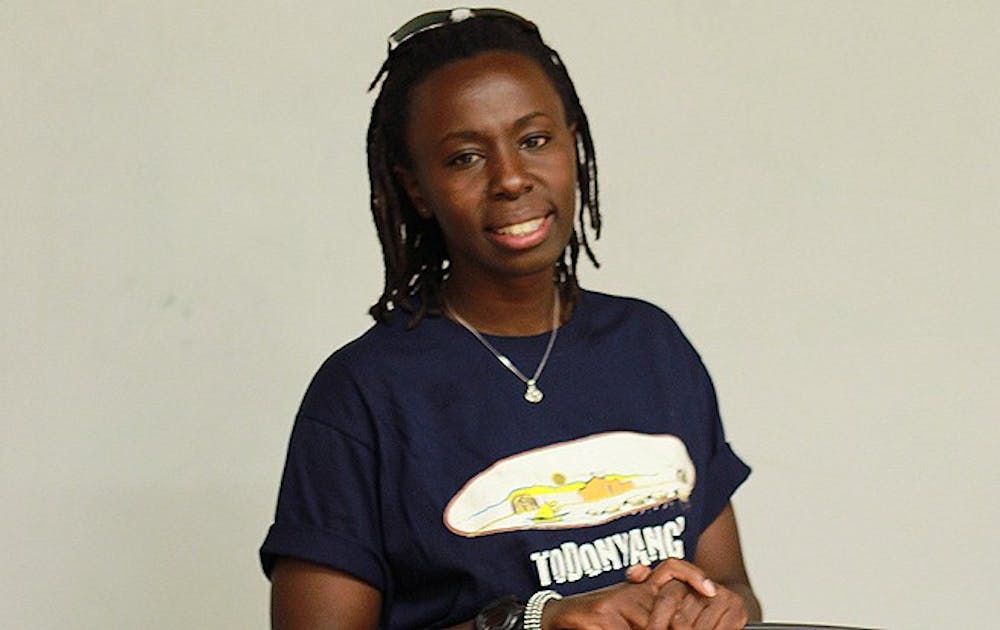Ikal Angelei won the Goldman Environmental Prize—the largest award for grassroots environmentalism—this year for her efforts to fight for the tribes in the Lake Turkana region of Kenya against the construction of the Gibe III Dam in Ethiopia. The dam, if completed, would deplete water flow into the already water-scarce Lake Turkana region, exacerbating existing issues of poverty and resource conflict facing the indigenous people there. Angelei sat down with The Chronicle’s Kelly Carroll for a one-on-one interview after speaking about her work at Duke Friday.
The Chronicle: What is or was your motivation for starting this project and continuing it now?
Ikal Angelei: My motivation for starting it was because my father, my biggest inspiration, he always believed that when there was something to be done, you then had to find a way to do it or get someone to do it. My inspiration to go on is really the people who I have been representing—the spot they’ve given me, and the belief and more and more understanding of their need for this resource.
TC: Did you ever foresee yourself doing something like this?
IA: No, I never did. It was instinctual—a situation had cropped up and somebody had to do it. It was not one of those things where people say, ‘I grew up knowing that I was going to be an activist.’ I just grew up not even knowing that I would make a difference. I just was always questioning the state of [things].
TC: How do you think winning the Goldman Environmental Prize will contribute to your project?
IA: It has created a lot of awareness around the issues. So more people who didn’t even know about it are now starting to want to know about it. It has also helped us in increasing our belief, just our hope for the struggle and possible support from interested donors to look at this as an area of interest in terms of resource rights.
TC: How does the need for electricity compare to the need for water in the area, especially at a time of drought?
IA: It’s highly improbable that we will fight for electricity. It’s evident that people have been fighting for water. So I think just by looking at that, human needs for water supersede human needs for electricity.
TC: Can a country like Kenya, which needs energy, ethically displace a few people to bring power to many?
IA: There is a possibility to get energy in any country. So at what expense do we want to develop this energy? I think it’s not right to displace or destroy people’s environments.
TC: Do you find there is a large disconnect between those benefitting from the dam and those being harmed by it? If so, has this been a major struggle in opposing it or finding support?
IA: It’s not extremely a disconnect. It’s just a sense of ignorance, because while all human beings need water or can appreciate the environment, it’s just a lack of understanding on the issues. And that’s what creates the disconnect, the lack of understanding or the lack of information.
TC: What is the role of foreign investment in the Lake Turkana region? How have you managed to reach these investors and demonstrate to them the negative consequences of constructing the dam?
IA: There is an increased role in various interests from foreign investment. It has not been easy, but mainly trying to reflect to them the impact of their work on the regions and on their businesses. So sometimes you have to highlight the business risks.
TC: Why is China so invested in the project?
IA: We don’t know, really. China’s interest in Africa is through setting up infrastructure. So we don’t know if this is one of the ways of doing it, through setting up infrastructure to then get ground within the continent.
TC: Do you think that the environmental and social impact assessment was sufficient before the project began?
IA: It was nonexistent in the first place. Now the need is to actually do a comprehensive independent one.
TC: If you can’t stop the construction, what would be the next possible scenario?
IA: I think it’s to really look at how best the communities can cope with the different changes, trying to understand how best to protect the communities at the best level we can.
TC: What will happen to the 40 percent of the dam that has already been built if the investors pull out?
IA: It’s infrastructure, so you can use it as it is. So if it’s roads it’s going to be a better road network than in the region. If the dam has actually been put up they can just use it to make a small dam.
TC: How long do you think it will take for the issue to fall either in favor of building the dam or of pulling out?
IA: That’s something we can’t really predict. As I said, I started [grassroots organizing against it] six months in and now it’s four years old. I think for me, I am willing to go on for as long as my bones will allow me to go.
TC: If you could give one reason to convince the world and especially the investors to stop the construction of the dam what would it be?
IA: We’ve seen conflicts around the world based on natural resources. That is just the beginning. With an increase in population, we are changing environments. We are part of the problem. And we are part of this problem by increasing the conflicts in the name of development.
Get The Chronicle straight to your inbox
Signup for our weekly newsletter. Cancel at any time.

